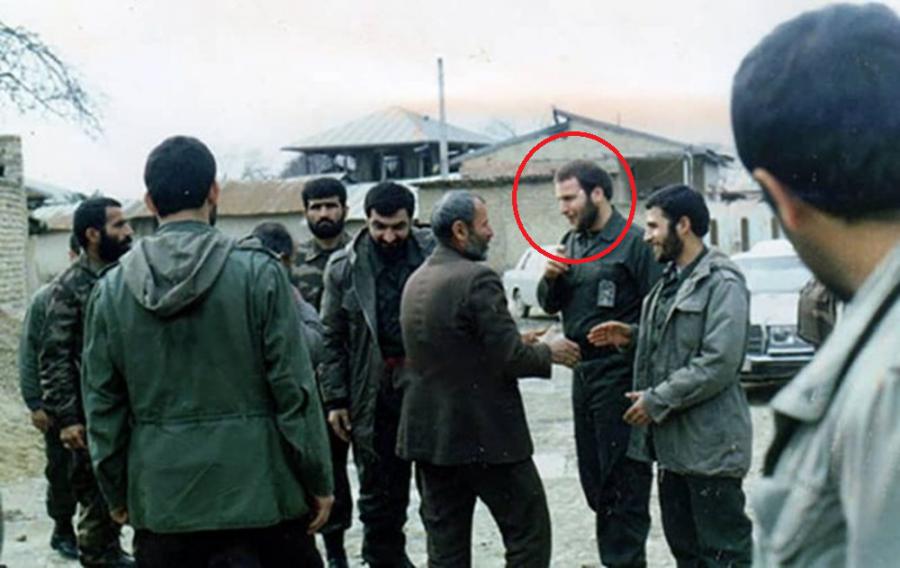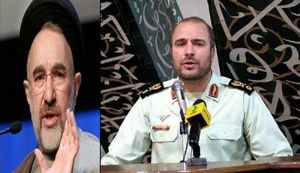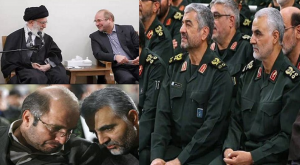
(Video) Ambitious Transformation: Mohammad Bagher Ghalibaf’s Journey from Hooligan to Speaker and Presidential Contender
Throughout his notorious career, Mohammad Bagher Ghalibaf’s track record has been marked by a simultaneous repression of protests and ambitious power grabs.
PARIS, FRANCE, June 15, 2024 /EINPresswire.com/ -- The National Council of Resistance of Iran (NCRI) Foreign Affairs Committee in an article published that Mohammad Bagher Ghalibaf was born on August 23, 1961, in Torghabeh, Khorasan Razavi Province.
His brother Hassan Ghalibaf Torghabeh was killed during the war with Iraq in what the regime labeled “Operation Karbala-4.”. M.B. Ghalibaf has been a member of the Expediency Discernment Council, the former mayor of Tehran and Parliament Speaker for the last three years.
According to official data, Ghalibaf studied political geography at the University of Tehran for his master’s degree and obtained his PhD in the same field from Tarbiat Modares University.
His doctoral thesis focused on the evolution of local institutions in contemporary Iran. He completed Airbus pilot training in France and is an assistant professor in the political geography department at the University of Tehran. Newsweek ranked Ghalibaf as the eighth most powerful person in Iran in 2009.
1979-1980s: Early Career and Military Involvement
Ghalibaf began his career in Basij following the 1979 Revolution and went to Kurdistan to help the Islamic Revolutionary Guard Corps (IRGC) quell local protests. He later went to the southern fronts at the onset of the Iran-Iraq war and joined the IRGC early in the war. He mainly held responsibilities in war intelligence operations, and later commanded the Imam Reza Brigade and the Nasr Khorasan Division.
After the conclusion of the Iran-Iraq war, M.B. Ghalibaf was appointed as the commander of the IRGC Najaf Headquarters in Kermanshah. Subsequently, he was promoted to deputy commander of the Basij Resistance Force.
In 1982, he was appointed commander of the Nasr Division of Khorasan and later worked in the command of the 25th Karbala Division.
1993-1997: Command of Khatam-ol-Anbiya Construction Headquarters
In 1994, Ghalibaf assumed the role of commander at the Khatam-al Anbiya Construction Headquarters. During his tenure, he is credited with significant contributions to several major infrastructure projects, including the Mashhad-Sarakhs railway, the gas supply to five central and western provinces, the construction of marine structures in the Persian Gulf, and the building of the Karkheh Dam.
1997-1999: Command of the IRGC Air Force
In 1997, Supreme Leader Ali Khamenei appointed M.B. Ghalibaf as the commander of the IRGC Air Force. During his tenure, he traveled to France to participate in Airbus pilot exams. Ghalibaf served as commander for three years, which included the period of the attack on the Tehran University dormitory in 1999.
Additionally, Ghalibaf’s time in command was marked by a notable conflict over land in Shiraz. Amir Shahram Rostami, in an interview, recounted a clash between the IRGC Air Force and the Shiraz Airborne Division of the regular army.
Rostami claimed that despite orders from the Supreme Leader, the IRGC Air Force attempted to seize part of the Shiraz Airborne Division’s land, leading to a military confrontation and the death of a Shiraz Airborne soldier.
Following this incident, the judiciary and the Armed Forces General Staff questioned Shahram Rostami, but no inquiries were made into Ghalibaf’s actions.
1999: Suppression of Protests
Following the 1999 uprising that started at the Tehran University dormitory, M.B. Ghalibaf, then commander of the IRGC Air Force, signed a letter threatening then-President Mohammad Khatami with military intervention if the government did not control the unrest.
A few days after the attack, the newspaper Kayhan published a confidential letter from the IRGC commanders to Khatami, warning that their patience was exhausted and that they would act if the government failed to restore order.
In a controversial speech during his 2013 presidential campaign, Ghalibaf said he was proud of his involvement in the crackdown on the 1999 protests, where he rode a motorcycle and used a baton against demonstrators. He stated that he co-authored the threatening letter and actively participated in suppressing the protests.
1999-2004: Command of Iranian Police
Ghalibaf appointed his deputy, Azizollah Rajabzadeh, the head of Tehran’s Disaster Mitigation and Management Organization. Rajabzadeh was implicated in the 2009 Kahrizak detention center incidents, where the regime’s security forces brutally tortured and murdered people who were arrested during the anti-regime protests.
In a December 29, 2012 speech, Ghalibaf said, “The leaders of sedition in the 2009 elections are criminals, and it is wrong to say that they can return with an apology.” He referred to the protesters as “seditionist regime change activists,” describing them as “a small minority who have always been eliminated and expelled by the Iranian people and political movements within the system.”
2004-2017 Presidential Ambitions and Mayoralty
Mohammad Bagher Ghalibaf ran for president in 2004 but finished fourth. After his defeat, he was nominated for the position of Mayor of Tehran, along with Mohammad Ali-Abadi and Mohammad Ali Najafi. In Iran’s state-affiliated institutions, influential connections often play a crucial role.
On September 4, 2005, the City Council elected Ghalibaf as Mayor, succeeding Mahmoud Ahmadinejad, who had vacated the position to become president. Ghalibaf secured eight 8 out of 15 votes in the council.
After another round of anti-regime protests broke out in February 2011, Ghalibaf condemned the demonstrators, labeling the event as “satanic” and accusing the protest leaders of lacking political maturity, religion, and intellect. He equated their actions to those of the People’s Mojahedin Organization (PMOI/MEK).
His period in office was marked by significant infrastructure projects, but also serious allegations of extensive financial corruption and lack of transparency in the municipality’s accounts. Following the 2013 municipal elections and the arrival of new council members, rival factions questioned the legality of the municipality’s financial activities and called for an investigation into its multiple financial accounts.
In September 2016, Mohammad Bagher Ghalibaf was accused of corruption following a report by the General Inspection Office, which revealed that a vast amount of municipal properties had been sold at significant discounts to various individuals and cooperatives.
Although the judiciary shut down several websites and arrested the editor-in-chief of Memari News, the whistleblower, the outcome of Ghalibaf’s legal proceedings was never disclosed.
In 2013, Ghalibaf once again ran for president with the campaign slogan “Proud Iran,” announced to be second by the Minister of Interior. On September 8, 2013, he was re-elected as Mayor of Tehran by a majority vote in the City Council for a third term. During the 2013 presidential debates, Hassan Rouhani revealed that Ghalibaf had planned a severe crackdown on student protests in Tarasht in 2003.
Rouhani disclosed that Ghalibaf had proposed an aggressive plan to deal with the students. Additionally, a leaked audio file from a National Security Council meeting showed Ghalibaf demanding permission for police to enter universities and use force against protesters, threatening to “crush” anyone who defied orders.
2017: Presidential Campaign and Withdrawal
In 2017, Mohammad Bagher Ghalibaf once again ventured to test his fortunes for the second-highest seat of power within the clerical regime. Confident in his network and influential allies within the IRGC and governmental circles, he embarked on an effort to secure a mandate for the presidency.
Yet, unbeknownst to him, Khamenei’s plans favored Ebrahim Raisi for his succession and as the linchpin of the regime’s survival mechanism. Despite ultimately yielding under pressure in favor of Raisi, Ghalibaf nursed a deep-seated resentment towards Raisi who also failed to secure the presidency.
This bitterness fueled his subsequent quest for the speakership position in the parliament, seeking to assert his influence and reclaim lost ground.
2017-2019: Expediency Discernment Council and Parliament
From August 2017 to June 2019, Ghalibaf served as a member of the Expediency Discernment Council.
Familial Corruption
Ghalibaf’s wife, Zahra Sadat Moshir, and his son Elias have been accused of corruption in several educational and economic cases. This issue was brought up during the electoral debates by Mohammad Ali Vakili, the spokesman for Rouhani’s election office.
He claimed that the economic activities of Ghalibaf’s son, both domestically and internationally, as well as his involvement in the non-profit education sector, particularly the Shams Al-Shams educational complex, were rife with corruption.
This educational institution, owned by Ghalibaf’s son, is located in the affluent Saadat Abad area of Tehran. Reports also emerged in 2015 regarding the involvement of Ghalibaf and his son in a corruption case worth 1200 billion tomans. Zahra Sadat Moshir was implicated as the primary suspect in a corruption case related to the Imam Reza Charity Foundation, which was published by the Shargh newspaper in November 2016.
Besides the cases involving the Ghalibaf family, their managers have consistently been among the accused. One of the most prominent cases is the Yas Holding case, which alleges corruption against Isa Sharifi, the deputy mayor of Tehran during Ghalibaf’s tenure.
The scale of this corruption case reaches up to 10 trillion tomans. In the latest development, Morteza Alviri, a member of the Tehran City Council, stated that 12 corruption cases related to Ghalibaf’s mayoralty have been forwarded to the judiciary.
2020-2023: Speaker of the Parliament
Mohammad Bagher Ghalibaf became speaker of parliament on May 28, 2020, and has held the position ever since by order of Khamenei. According to information disclosed by the opposition group “GhiamSarnegouni,” Ghalibaf has essentially been a facilitator for the Supreme Leader’s office and the IRGC by pushing forward their desired legislation and budget bills through influence and using his faction in the parliament.
Due to his rivalry with Raisi, Ghalibaf posed numerous challenges in passing Raisi’s government bills. Consequently, Khamenei opted to use influential figures like Hamid Rasaee, Amir Hossein Sabati, Mahmoud Nabavian, and Ali Akbar Raefipour to undercut Ghalibaf.
The objective was to undermine his position and thwart his path to a speakership in 2024. However, following Raisi’s demise in May 2024, Khamenei’s influence waned significantly. Faced with the prospect of a major conflict within the newly established parliament, already rife with internal feuds, Khamenei was compelled to once again endorse Ghalibaf’s presidency to avert further turmoil.
State media have claimed that Ghalibaf’s speakership was secured as a result of promises he made to members of the faction close to former president Ali-Akbar Rafsanjani, pertaining that he would not enter the presidential election race. A commitment he did not uphold.
Conclusion
Leveraging influence and powerful allies, he has consistently sidelined influential rivals and, through displays of unwavering loyalty and demonstration of his capabilities, managed to sway Khamenei’s opinion, albeit without genuine admiration.
The network of relationships and power that Ghalibaf has cultivated for himself and his inner circle is so robust that despite numerous revelations of corruption involving him, his family, and close associates, his network has remained largely immune to legal repercussions. Unlike many of his seasoned counterparts, Ghalibaf has, to this day, eluded the grasp of the judiciary, firmly entrenched within the corridors of power.
If you wish to receive the NCRI weekly Newsletter, please use the following link to subscribe: https://bit.ly/3SMgEla.
Shahin Gobadi
NCRI
+33 6 61 65 32 31
email us here
One of the most prominent cases is the Yas Holding case, which alleges corruption against Isa Sharifi, the deputy mayor of Tehran during Ghalibaf's tenure.
EIN Presswire does not exercise editorial control over third-party content provided, uploaded, published, or distributed by users of EIN Presswire. We are a distributor, not a publisher, of 3rd party content. Such content may contain the views, opinions, statements, offers, and other material of the respective users, suppliers, participants, or authors.






